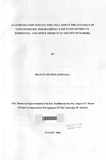| dc.description.abstract | The purpose of all pre-tender estimates is to provide an indication of the probable cost of the new
construction. Decision-making at the early stages of a project, initial appropriations and economic
feasibility studies are based upon the preliminary or pre-design cost estimates. It is apparent that
predicting costs accurately is a problem in construction industry especially at tender stage.
The methods used to predict project building costs include the unit method, floor area method,
approximate quantities, elemental analysis and pricing of bills of quantities before tender.
This research sought to determine the magnitude of the influence of cost estimating methods used
in the prediction of construction costs. It also identifies other factors that cause inaccuracy and
their magnitude of this effect on overall accuracy. The study hypothesis is that cost estimates do
not accurately project pre-design stage costs used as a guide for investment decision making
process.
This work adopts a survey research design and concentrates on private residential and office
buildings in city of Nairobi. The population of which is the number of projects handled by
professional quantity surveying firms. The resultant data is then analysed by the SPSS software to
derive correlation, regression and resultant statistical parameters.
This research examined the problem of the quality of conceptual estimating. It assessed the usage
of historical and empirical information which had been used in the pre-tender cost estimates, and
ascertained whether it is possible to get an 'appropriate initial assessment of the expected accuracy
and reliability of a cost estimate. This is then compared with successful bidder or the lowest tender
figure awarded the contract.
The findings of this research is that pre-design cost estimates as currently used in the industry do
not significantly project the actual construction costs and this negates their reliance as a guide for
investment decision making process. The research recommends that a more elaborate database be
developed and other building parameters such as building type, and project scope, which the study
found significant should be incorporated.
The study concluded that the building type and scope/size of projects arc the major determinants
of cost estimating functions. The study recommends that the quantity surveying critical on the type and scope size of the office and residential buildings when doing their cost
estimations | |

